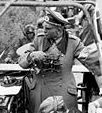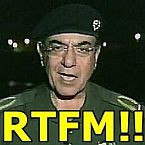Iņaki Harrizabalagatar
Posts: 825
Joined: 12/11/2001
Status: offline

|
quote:
ORIGINAL: jaw
quote:
ORIGINAL: Iņaki Harrizabalagatar
I imagine that besides range, armor has the advantage of mobility and, of course, armor. I mean, I imagine squads have an anti armor value independent of their anti infantry value, right? and armor units will have different armor levels.
I also imagine that, besides range, terrain will provide some defense bonus, depending on terrain.
Letīs imagine the combat between an infantry division and an armor division. At long range only artillery would play, but it would be largely ineffective over armor units. At medium range infantry could use their antitank guns against armor, but they are handicapped because they are not armored (so can be destroyed by artillery and medium range mortar fire) and because theyt are largely inmobile, against mobile armor. Finally, at close range, infantry could use many other antitank weapons, but again tanks, as well as their armor, have the defense of their mobility. Am I right in these assumptions for the game?
In general yes but here is how it actually works using your example of an armored division versus an infantry division. Each of these divisions is composed of a variety of combat arms (or what I like to call combat elements). The armored division has AFVs in addition to infantry, engineers, and a variety of crew served weapons. The infantry division is similar except for having little or no armor. All of these combat elements are equipped with actual weapons. For example, a typical tank has a main gun and one or more machine guns. These weapons are individually rated for range and effectiveness against armored and non-armored targets. A typical infantry squad would have 8 or more men and a corresponding number of small arms including rifles, sub-machine guns, probably a light machine gun, and grenades (actual composition depending on nationality and period of War).
Now assume the armored division attacks the infantry division. The first round of combat begins at a randomly determined range between 20,000 and 30,000 yards. Only indirect fire artillery capable of that range would fire in this first round. (I'm not certain but I believe combat is simultaneous.)
The second round of combat would occur at 1/4 the range of the first round. For matematically simplicity let's say the first round was at 20,000 yards so the second round would be at 5,000 yards. This range is still greater than any direct fire weapon in the game so again only indirect fire weapons would participate but now more weapons like heavy mortars would also get to fire.
The third round of combat would occur at 1/4 the range of the second round or 1,250 yards. At this range, depending on the terrain, some direct fire weapons would now also participate plus all indirect fire artillery in range. Terrain permitting, tanks with long enough range guns could engage both armored and non-armored targets.
The fourth round of combat would occur at 1/4 the range of the third round or 300 to 350 yards (range is measured in 50 yard increments). Terrain permitting, machine guns, rifles, anti-tank rifles, light mortars would join the fray.
The fifth round of combat would occur at 1/4 the range of the fourth round or 50 to 100 yards. If the range is 50 yards this is the final round of combat; if the range of the fifth round is greater than 50 yards there would be a sixth round. The 50 yard range is close combat were weapons like grenades and sub-machine guns come into play.
After all these rounds of combat effect of damage is accessed and the defending unit will either hold its ground or be forced to retreat or worse.
One Thing I recall I didnīt like about TOAW is that, for instance, an AA 88mm had exactly the same statistics that one mounted in a Tiger, while it is clear that a gun mounted on a tank has the big advantage of mobility, being able to reposition in no time, is that factored in this game? I
|
 Printable Version
Printable Version








 Armor is at a big disadvantage in urban fighting.
Armor is at a big disadvantage in urban fighting. 





 New Messages
New Messages No New Messages
No New Messages Hot Topic w/ New Messages
Hot Topic w/ New Messages Hot Topic w/o New Messages
Hot Topic w/o New Messages Locked w/ New Messages
Locked w/ New Messages Locked w/o New Messages
Locked w/o New Messages Post New Thread
Post New Thread